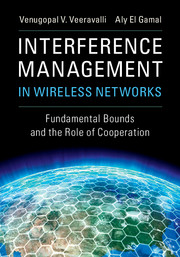Book contents
- Frontmatter
- Contents
- Preface
- Acknowledgments
- 1 Introduction to Interference Management
- 2 System Model and Sum Capacity Characterization
- 3 Degrees of Freedom and Interference Alignment
- 4 Iterative Algorithms for Interference Management
- 5 Degrees of Freedom with Coordinated Multi-Point Transmission
- 6 Locally Connected Channels with CoMP
- 7 Backhaul Load Constraint
- 8 Cellular Uplink
- 9 Dynamic Interference Management
- 10 Recent Advances and Open Problems
- Appendix A Information Theory
- Appendix B Algebraic Geometry
- References
- Index
1 - Introduction to Interference Management
Published online by Cambridge University Press: 09 February 2018
- Frontmatter
- Contents
- Preface
- Acknowledgments
- 1 Introduction to Interference Management
- 2 System Model and Sum Capacity Characterization
- 3 Degrees of Freedom and Interference Alignment
- 4 Iterative Algorithms for Interference Management
- 5 Degrees of Freedom with Coordinated Multi-Point Transmission
- 6 Locally Connected Channels with CoMP
- 7 Backhaul Load Constraint
- 8 Cellular Uplink
- 9 Dynamic Interference Management
- 10 Recent Advances and Open Problems
- Appendix A Information Theory
- Appendix B Algebraic Geometry
- References
- Index
Summary
In this chapter, we provide a high-level introduction to interference management in wireless networks, including a historical perspective on wireless cellular networks, and an overview of the remaining chapters in the book. We also summarize the notation used in the book.
Interference Management in Cellular Networks: A Historical Perspective
Managing interference from other users sharing the same frequency bands has been the key driver for mobile wireless communications. The first wireless phone systems served as extensions to the wired public switched telephone network [1]. These systems were “single cell” systems in the sense that mobile terminals could be connected to only one basestation during a call, with the call being lost when out of range of the basestation, akin to losing an FM radio signal while driving out of range of the station. Interference in these networks could be managed by simply orthogonalizing the users in the time–frequency plane, i.e., through the use of time-division multiple-access (TDMA) or frequency-division multiple-access (FDMA), or some combination of the two. Interference between basestations operating in the same frequency band was managed by ensuring that they are geographically far apart, again akin to the way in which radio stations operating in the same frequency band are placed.
Cellular Concept
A major breakthrough toward improving both the capacity and the mobility in wireless phone systems came with the introduction of the cellular concept [2]. In the cellular system design, a given geographical region is split into contiguous regions called “cells,” without any gaps in coverage. The system is designed so that cells that use the same frequency band are far enough from each other to cause little interference to each other. The number of different frequency bands is called the reuse factor of the system. The reuse factor is a measure of spectral efficiency in the system, with a larger reuse factor corresponding to a smaller efficiency. A key innovation in the cellular concept is the introduction of handoff between neighboring cells operating in different frequency bands, which allows a mobile user to maintain a continuous connection while moving through the geographical region. Interference management within each of the cells is achieved by orthogonalizing the users in the time–frequency plane.
- Type
- Chapter
- Information
- Interference Management in Wireless NetworksFundamental Bounds and the Role of Cooperation, pp. 1 - 5Publisher: Cambridge University PressPrint publication year: 2018



